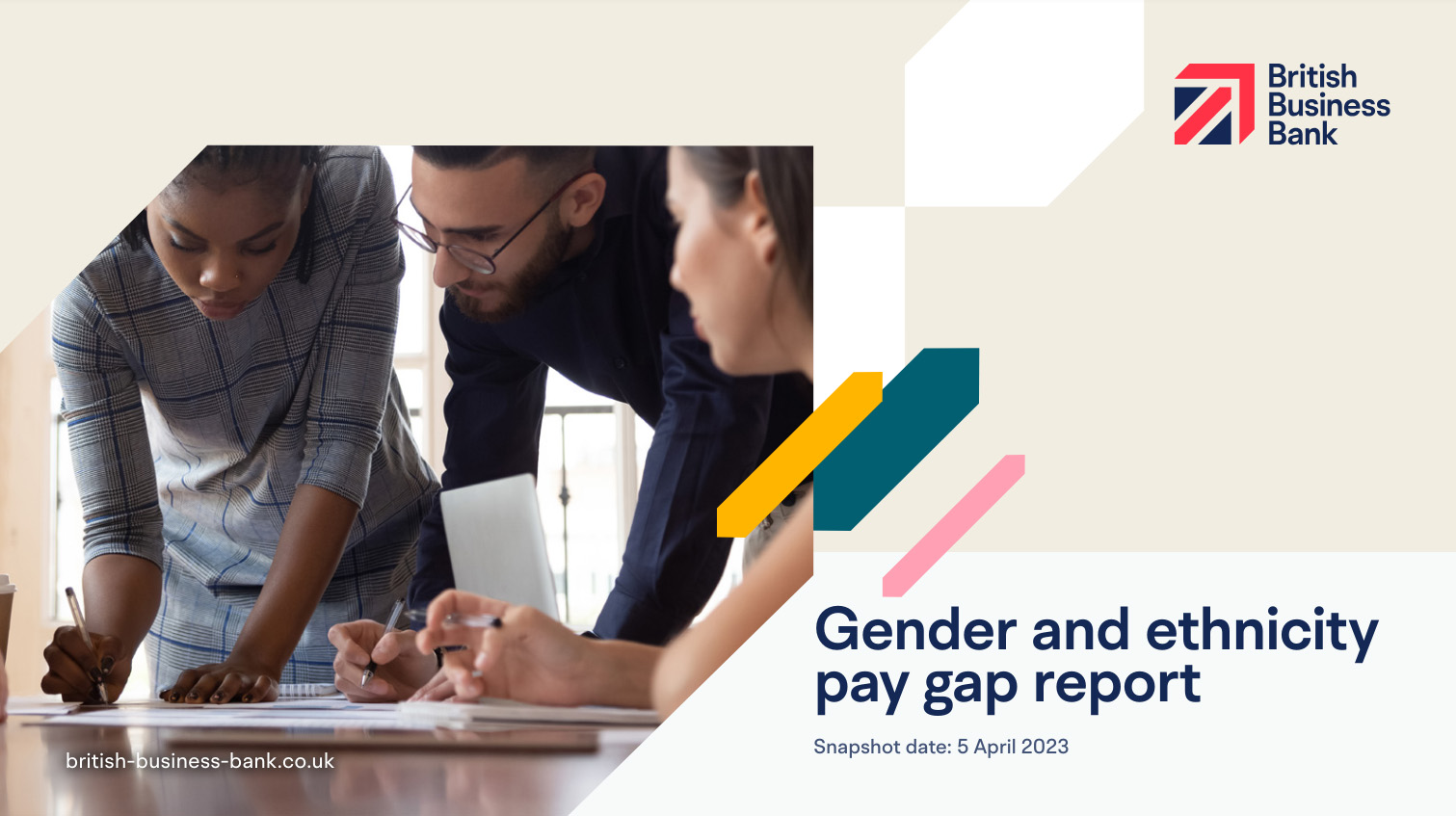
Gender and ethnicity pay gap report 2023
Our 2023 gender pay gap at a glance
Proportion of male and female colleagues in each pay quartile
| Headcount | Percentages | |||
|---|---|---|---|---|
| Quartile | Male | Female | Male | Female |
| Upper quartile | 88 | 53 | 62.4 | 37.6 |
| Upper middle quartile | 85 | 58 | 59.4 | 40.6 |
| Lower middle quartile | 66 | 74 | 47.1 | 52.9 |
| Lower quartile | 72 | 69 | 51.0 | 49.0 |
Each pay quartile represents a quarter, or 25%, of our total workforce ranked by pay
Gender pay gap (As a % of mean/median male pay)
| Male | Female | Pay Gap | |
|---|---|---|---|
| Median hourly rate | £29.90 | £25.05 | 16.20% |
| Median annual salary | £58,512 | £49,011 | 16.20% |
| Male | Female | Pay Gap | |
|---|---|---|---|
| Mean hourly rate | £32.74 | £29.90 | 8.7% |
| Mean annual salary | £64.063 | £58.519 | 8.7% |
Gender bonus gap (As a % of mean/median male bonus)
| Element | 2023 |
|---|---|
| Median % | 43.9 |
| Mean % | 24.7 |
Proportion of male and female colleagues
| Gender | 2023 |
|---|---|
| Male % | 55 |
| Female % | 45 |
Proportion of male and female colleagues receiving bonuses
| Gender | 2023 |
|---|---|
| Male % | 66.1 |
| Female % | 66.8 |
Reporting gender pay gaps - an overview
In the UK, public, private and voluntary sector organisations with 250 or more employees are required to report on their gender pay gaps annually. The reports show the difference between the average earnings of men and women, expressed relative to men’s earnings. If an organisation reports a gender pay gap, it does not mean women are paid less than men for doing the same job, but it does show that, on average, men occupy higher-paying roles than women.
Employers must report six different measures, based on a snapshot of pay data on a date set out by the Government Equalities Office:
Median gender pay gap – the difference between the median hourly rate of pay of male full-pay relevant colleagues and that of female full-pay relevant colleagues.
Mean (average) gender pay gap – the difference between the mean hourly rate of pay of male full-pay relevant colleagues and that of female full-pay relevant colleagues.
Median gender bonus gap – the difference between the median bonus paid to male relevant colleagues and that paid to female relevant colleagues.
Mean (average) gender bonus gap – the difference between the mean bonus paid to male relevant colleagues and that paid to female relevant colleagues.
Bonus proportions – the proportions of male and female relevant colleagues who were paid bonus during the relevant period.
Quartile pay bands – the proportions of male and female full-pay relevant colleagues in the lower, lower-middle, upper-middle and upper quartile pay bands.
Additional definitions
Mean is the average of a set of numbers is calculated by adding up all the values and then dividing the sum by the total number of values.
Median is a measure of central tendency in a set of data. It represents the middle value when the data set is ordered or ranked.
Hourly pay is the total of salary and any cash allowances paid, before any deductions for tax, calculated as an hourly rate. The figure used for the 2023 gender pay gap is the hourly pay for April 2023. Colleagues who did not receive their normal full pay during that month for any reason are excluded from the calculation.
Bonus for the purpose of calculating the bonus gap is the total bonus and/or long-term incentive paid during the previous 12 months to all colleagues who were employed on the snapshot date of 5 April 2023. For the Bank, this means bonus payments made in June and August 2022 in respect of the financial year ending 31 March 2022, and long-term incentive payments made in August 2022 in respect of the three-year performance cycle that ended in March 2022.
Headlines about the gender pay gap tend to focus on the median figure, which ignores extremes and is therefore thought to be the most representative measure. It is, however, important to report all of these measures. Each one tells you something different about the underlying causes of the gender pay gap and each one can mask issues that another may highlight.
If there is a big difference between an organisation’s mean and median pay gap, this indicates that the dataset is skewed – either by the presence of very low earners (making the mean lower than the median), or by a group of very high earners (making the mean bigger than the median).
Taking a ‘snapshot’ of this data on a set date, as required by regulation, creates a level playing field for all reporting organisations. However, it masks the fluidity of gender pay gaps, which can fluctuate from month to month and across pay quartiles depending on changes to headcount.
What is our gender pay gap?
Colleague profile
In the UK we had 565 colleagues on the snapshot date of 5 April 2023, of whom 311 were men (55%) and 254 were women (45%).

Our gender pay gap
Our analysis shows that the median gender pay gap between men and women’s earnings is 16.2%, based on hourly rates of pay at the snapshot date. This is a reduction of 4.4 percentage points from the gap we reported in 2022. Our mean gender pay gap has also reduced to 8.7%, from 11.0% last year (2.3 percentage points). The gender pay gap is calculated as the difference between average hourly earnings of men and women as a proportion of men’s average hourly earnings. It is a measure across all jobs in the company, not of the difference in pay between men and women for doing the same job.
The proportion of men and women in more senior, higher-paid roles, has a significant influence on our gender pay gap. At the reporting date for the gender pay gap, 59.9% of all colleagues at Senior Manager levels and above (Bands 1 to 5) were men, while at our most junior levels (Band 6 & 7), the distribution is split equally at 50%.
Overall, we made progress towards a more balanced proportion on men and women in the workforce in the year to April 2023, with the percentage of female colleagues increasing by 2% to 45%.
The imbalance between men and women in more senior roles, while typical of a great many employers in the UK, remains a key area of focus for the Bank. Later in this report, we explain some of the initiatives we are undertaking with the aim of increasing the proportion of women in senior roles, including the progress reported by the Bank against its Women in Finance targets in July 2023.
The current imbalance however does help to explain the Bank’s gender pay gap. When we consider the pay gap separately for each employee grade (‘Band’) within the Bank, the gap is much lower.
What this tells us is that the Bank’s pay gap is not an equal pay issue - men and women are paid equally for doing equivalent jobs across the firm.
However, we know we cannot afford to be complacent about this. We continue to make sure that our policies and practices are fair. This includes actively reviewing individual decisions around our annual salary, promotion and recruitment processes.
Our gender bonus gap

The median gender bonus gap between men and women’s bonus payments is 43.9%, which is significantly higher than it was last year at 25%. The mean gender bonus gap has also increased from 13.1% to 25.0% (11.9 percentage points)
The 2023 gender bonus gap reflects bonus payments made in June and August 2022, in respect of the financial year ending 31 March 2022. During this period, 66.8% (177) of female colleagues, and 66.1% (209) of male colleagues received a bonus. Only colleagues who joined the Bank on or before 31 December 2021 were eligible, and for both men and women, the proportion of colleagues receiving a bonus closely reflected the proportion who were eligible for a bonus or long-term incentive award. The Bank continued to grow rapidly during the bonus year, which is why – for both men and women – a portion of joiners (187 (32.2%)) were not eligible for a bonus.
There are several factors that can influence the level of an individual colleague’s bonus or long-term incentive award.
Both plans incorporate an element that reflects the Bank’s performance as a whole against its strategic objectives, and an element that reflects individual colleagues’ performance ratings for the bonus year. Each year we monitor the award of performance ratings carefully to ensure that the distribution of ratings is the same for women as it is for men.
Potential bonus or long-term incentive levels increase for more senior colleagues as a percentage of salary. While this incentive structure is typical of many employers, it does have a bearing on our bonus gap, as there is a greater proportion of male than female colleagues at the Bank in senior grades as has been previously noted.
The gender bonus gap is further impacted by part-time working. Regulations require that bonus calculations include actual bonuses received by part-time colleagues rather than full-time equivalent amounts, which means that, for the gender pay gap calculations, average bonus levels for part-time colleagues are generally lower than they are for full-time colleagues. Less than 5% of roles at the Bank are part-time and 85.7% of these are undertaken by women, so the methodology for calculating part-time bonuses has a higher impact on average bonuses for women than it does for men.
Other factors that influence bonus levels at the Bank are individual colleagues’ length of service during the year, and the fact that, for our most senior colleagues (Band 1 and 2), incentive payments may be deferred for up to two years.
Once a colleague’s performance rating for the year has been determined, there is little or no discretion for managers to adjust formulaic bonus or incentive plan outcomes. On this basis, we are confident that our gender bonus gap is due to structural factors such as the proportion of men and women in senior roles, rather than to any gender-related bias. We remain committed to ensuring that all pay, and bonus decisions are free of any form of bias through a combination of line manager training, clear guidance, and robust governance.